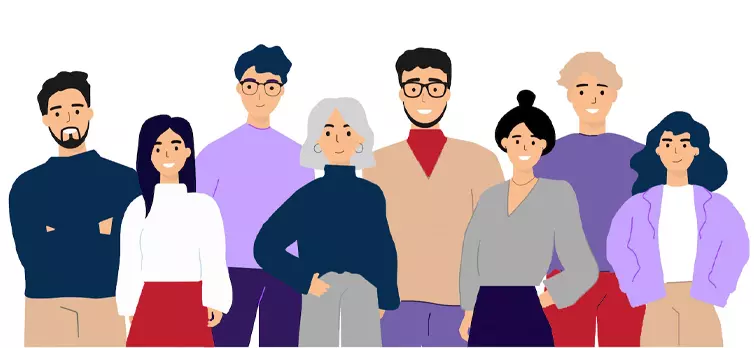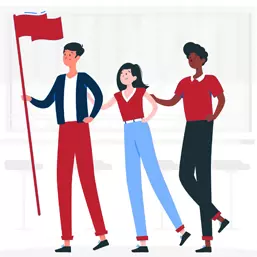
Members of a Collaborative Team
The strength of the team is the individual member. The strength of each member is the team.
– Phil Jackson
Introduction
There is a reason why this type of writing is referred to as “collaborative.” In order to produce a final written product, participants in a collaborative business writing project need to work together as a group, also known as a team. While still contributing to the achievement of the group’s objective, individual members are typically given specific roles or responsibilities to fulfil. It’s possible that we won’t always get a say in who joins our team, but at least we can ensure that everyone has the opportunity to showcase their skills and make meaningful contributions to the final product.
The Selection of the Team Leader
Each group is comprised of a one-of-a-kind collection of members. Everyone has their own unique approach to their work, their moods, their personalities, and even their methods of learning. During the course of the project, there is a high probability that members of the team will engage in conflict with one another and experience roadblocks. The selection of an appropriate team leader, on the other hand, can not only be of assistance during times of conflict, but it also has the potential to avert a significant number of the issues that may develop.

A member of the team who is able to monitor the flow of progress and guarantee that the project is continuing down the path toward its successful conclusion is known as the team leader. Because of this, they need to be able to delegate responsibilities, monitor progress, resolve disagreements as they come up, and give timely feedback to every member of the team.
A leader should have the following characteristics:
- Be knowledgeable about the project;
- Be knowledgeable of the procedures and processes of the company;
- Be a good team player;
- Be able to communicate with other members of the team;
- They may not have all the answers, but they will get them;
- They may not have all the answers, but they will get them.
Brief check
Employees who have been groomed and permitted to advance through the ranks are frequently the most successful leaders because they understand the duties at hand and empathise with the obstacles that arise as a result of the task.
The Selection of the Chief Editor
The individual who is normally responsible for reading and editing all work that was contributed by other team members is the person who serves as the chief editor of the team. In addition to this, they need to be able to organize all of this information into a final draught that is presentable. How they do this will depend on the type of collaborative style that the team choose to use. Because the chief editor will frequently need to communicate with the members of their team regarding missing or incorrect submissions, as well as the likelihood that certain works will require revisions, it is crucial for the chief editor to have strong communication skills with their team members.
Qualities that define a chief editor are as follows:
- Be familiar with the project;
- Know how to use proper grammar, spelling, and context;
- Have effective communication skills with the other members of the team;
- Be able to manage and organize multiple submissions from other members of the team.

Members of the Team: Their Traits and Qualities
In conclusion, one of the aspects of the collaborative team that is one of the most significant is the members of the team themselves. After all, there would need to be someone else involved in order for the partnership to be successful. If an employee wants to participate in a collaborative team, they need to have specific qualities and ways of behaving in order to mesh well with the other members of the team. The members of the team need to be willing to collaborate with other people and have meaningful conversations with those people.
They need to be open to picking up additional responsibilities and helping out other members of the team whenever there is a lull in activity or not enough support. Members of an effective team are not only willing to share in the team’s successes, but are also willing to share in the team’s setbacks and failures. This is because they are aware that all that they do is done as a team.
Members of an effective team should exhibit the following characteristics:
Be willing to learn;
Be willing to participate in a variety of group activities;
Be able to support team members when necessary;
Have a flexible schedule and assignments;
Have realistic objectives and expectations for the group;
Be flexible in scheduling and assignments.
Brief check
When firms opt to cycle team member responsibilities, employees might take on roles such as team lead, recorder, researcher, editor, reporter, and others.
Writing Group that Works Together
Putting together productive collaboration teams may appear to be a daunting task, but after giving it some time and consideration, we may find that the options are actually quite obvious. When getting ready to join a group that will work together on a project, the first thing you should do is think about who you want to be the team leader. This person should help settle conflicts and keep an eye on the group. Discuss with the person in charge of this team who the most qualified candidate would be to serve as editor in chief. It is important to keep in mind that the role of editor in chief may require more than one person; therefore, you should not be hesitant to gather a few candidates for consideration.

The primary task should center on the members of the team that are required for the team. Choose individuals who have demonstrated both a willingness to learn new things and the capacity to assist their peers in meeting their goals. It is far more likely that members of a team and their leaders will be able to work together and function as a team if they have features in common that are comparable to one another.
The following are some considerations that should be made for a team:
- How many people do I need to assist me?
- To whom may I entrust the completion of the task?
- Which individuals have the qualities that are required?
Who among your contacts possesses the expertise required for your endeavor?
Practical Application
It was explained to Susan that in order to finish an annual report for higher management, she would need to organize a group of people to work together. She discussed the matter with John, who is her primary writer, and she requested him to take the role of team leader for the writing group.
Susan sent an invitation to James to assist her in selecting a group of reporters who were familiar with giving company presentations and would be able to supply a significant amount of information for the report. James’s chief editor, Mary will be assisting with the project and ensuring that it is developed in the appropriate manner after being selected by James. Susan conferred with James regarding the report and monitored its development over the course of the subsequent few weeks.
After it was done, Susan expressed her gratitude to the group for the wonderful work they had done and expressed her confidence that she would be able to contact them again in the future if she required additional collaborative work to be done.





